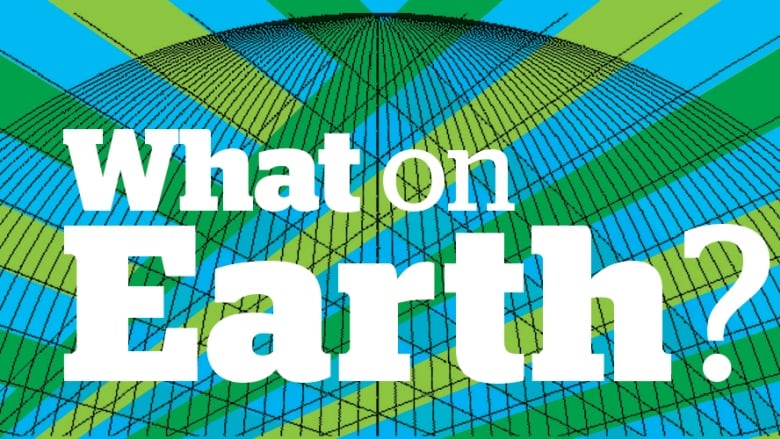Also: Climate scientists are tired of repeating themselves

Our planet is changing. So is our journalism. This weekly newsletter is part of a CBC News initiative entitled "Our Changing Planet" to show and explain the effects of climate change. Keep up with the latest news on our Climate and Environment page.
Sign up here to get this newsletter in your inbox every Thursday.
This week:
- Frazzled by all the plastic packaging on your produce?
- Turning invasive fish species into spies
- Climate scientists are tired of hearing how every month or year is one for the record books
Frazzled by all the plastic packaging on your produce?

For years, Susie Murphy has been looking for an alternative to plastic packaging for the organic greens she grows and sells.
The Antigonish, N.S.-based co-owner of Big Barn Little Farm has made an effort to reduce the amount of plastic the business uses in its farming operations. Yet, one aspect continues to elude her: how to sell her greens without single-use plastics.
Murphy tried selling greens in bulk, encouraging customers to bring their own containers, but it didn't catch on. She hasn't found a plastic alternative at an affordable price that will biodegrade in the composting facilities in the area where she lives.
"All we've come up with is a plastic bag — and everyone's trying to get rid of single-use plastics in every other aspect of our lives," she said.
For Myra Hird, a professor in the school of environmental studies at Queen's University in Kingston, Ont., Murphy's dilemma is "a very general and common problem."
Hird, who studies waste in Canada and globally, says individuals should "direct their energy away from feeling guilty about the amount of waste they're producing or the amount of packaging that they're buying," because it is largely out of the control of consumers.
By the time a plastic-wrapped produce item is unpacked at the local grocery store, it has just a fraction of the packaging that would have been needed to ship it there in the first place.
Rather than focusing on recycling some types of plastic, Hird says reducing is more crucial because "plastics are derived from fossil fuels." When plastic is recycled, the process still "requires more oil and or gas, so even when we're recycling plastics, we are using oil and gas," she said.
In the EU, a law called the Packaging Waste Directive would require countries to look to companies making products — instead of the people buying them — to reduce plastic packaging.
In Germany, for example, the VerpackG law holds companies selling products "legally responsible for the packaging," said Hird. "This in turn gives companies incentives to move much more quickly and effectively towards … eco packaging design."
That's because if a manufacturer is responsible for figuring out how to collect, dispose of or recycle its own packaging, it would likely want to produce less of it in the first place or make packaging that is more biodegradable or compostable.
There are companies trying to tackle that challenge of creating compostable plastic packaging alternatives.
"It's really difficult to completely eliminate plastic packaging, especially in settings like grocery stores," said Nuha Siddiqui, co-founder and CEO of Canadian-based Erthos. The company started as a side project while Siddiqui was attending the University of Toronto and now works with manufacturers around the world to develop materials that could substitute for plastics, including various types of packaging.
"We've designed various different raw materials that leverage plants and bio-based ingredients to replace traditional petroleum-based ones," said Siddiqui.
Some of the products in development could replace film plastic and clamshell packaging commonly used on grocery produce. By using byproducts of plants to create materials, Siddiqui says they are "designed to compost and return back into our earth."
This can be a big hurdle with some of the products currently available, says Hird. They may not be "biodegradable in the way people commonly think" because often they are tested in experimental conditions in labs.
Erthos is partnering with compost facilities to test their products and see how quickly they break down in real-life conditions, said Siddiqui.
Eventually, the goal is to design plastic alternatives that will last long enough for their use but will compost quickly enough once they're tossed away. Solutions like these could end up helping people like Susie Murphy as she tries to eliminate plastic from her business altogether.
— Molly Segal
Old issues of What on Earth? are here. The CBC News climate page is here.
Check out our podcast and radio show. This week: a dad's fight for a safe future for his child with Down syndrome. Meet Glen Hoos and find out why his daughter nominated him as a climate champion. What On Earth drops new podcast episodes every Wednesday and Saturday. You can find them on your favourite podcast app, or on demand at CBC Listen. The radio show airs Sundays at 11 a.m. ET, 11:30 a.m. in Newfoundland and Labrador.
Watch the CBC video series Planet Wonder featuring our colleague Johanna Wagstaffe here.
Reader feedback
Thomas Wolstenholme:
"Thank you for the heat pump diagram and explanation. That stated, as an engineer that has specified these devices over many years, there was one critical item that was missing: throughout most of Canada, one also needs an auxiliary heat source as air-to-air heat pumps do not perform well at colder temperatures. To be sure, the current ones, especially if they have the (so-called) low ambient temperature options, are far superior to the units available 20 years ago or more. But even so, most are either not providing sufficient heat at outdoor temperatures around –20 C or are cheerfully pounding their compressors to oblivion trying to heat the residence.
"Most auxiliary heat sources are electric heating coils. I myself have had a heat pump for many years but use a high-efficiency gas furnace for the lower temperatures, but so far this heating season the furnace has run only for a few hours on a single morning. As a major amount of fossil fuels are burned to heat houses during the autumn, early winter, late winter and spring, it is very easy to see that the offsets from carbon generation by using a heat pump during these periods is both significant and worthwhile. It is also worth noting that should a heat pump fail in service in much of Canada, especially in a cold spell, having an auxiliary heat source is necessary. I mention this as I've recently heard a few commentators stating, incorrectly, that they were unnecessary. (OK, I agree if one lives in Victoria or Vancouver.) Mechanical contrivances with a lot of moving parts do fail from time to time; all automobile owners know this, even the ones who own electric cars. It's simple logic."
Editor's note: The letter writer provided great context on the use of heat pumps in Canada, and we wanted to add a couple of points ourselves. First, traditional furnaces can fail as well, so a backup heat source (such as space heaters) may be a good idea for any system. Some insurance companies actually require a backup heat source for a heat pump in order for a homeowner to be covered. That said, many air-source heat pumps can now handle temperatures as low as –30 C.
Write us at whatonearth@cbc.ca.
Have a compelling personal story about climate change you want to share with CBC News? Pitch a First Person column here.
The Big Picture: Turning invasive fish species into spies

Invasive fish species have been a going concern in Canada's waterways for decades, but in recent years, wildlife officials have been employing a sneaky method to stop the spread of one of them — carp — in the Great Lakes. You might call it underwater espionage.
Four species of carp are considered invasive: bighead, black, grass and silver. They were brought into the U.S. in the 1960s and 1970s to relieve southern fish farms of algae, weeds and parasites but eventually found their way into the Mississippi River and then spread north. Carp are big and often muscle out native species and destroy the ecosystems they take over. They also tend to congregate in the spring and fall, so researchers decided to get the carp themselves to lead them to their hotspots.
To do that, researchers needed to turn some carp into (unwitting) double agents. They did this by catching the fish, implanting transmitters and then throwing them back in the water. Then, knowing the traitors' hangout, researchers and commercial anglers can head to that spot, drop in their nets and lines and remove multiple fish.
"The sooner we can find them … the greater the chance we have of actually stopping them or minimizing their impact in the Great Lakes," said Aaron Fisk, a researcher with the Great Lakes Institute of Environmental Research at the University of Windsor.
Hot and bothered: Provocative ideas from around the web
-
A growing number of power plants are "virtual" ones, comprised of networks of rooftop solar panels and backup batteries spread out on people's roofs and basements. Proponents say this could be a cheaper way to generate power.
- SUV and pickup truck commercials often feature them tearing through wild landscapes. Now, the U.K.'s advertising watchdog has banned a Toyota SUV ad featuring just such a scene because it "condoned the use of vehicles in a manner that disregarded their impact on nature and the environment."
- Think the carbon tax is driving inflation? National Observer columnist Max Fawcett posted a graph on X this week that shows it's not a big factor.
- "Naked clams" could be the next sustainable food coming to a menu near you. Researchers have found that the marine creatures, more commonly called shipworms and known as pests, are extremely nutritious and can be grown in a way that makes them even more so.
-
Leasing their land for wind turbines can help farmers sustain their business when times are tough. One rancher explains why wind farming is his "best cash crop."
Climate scientists are tired of hearing how every month or year is one for the record books

The U.S. National Oceanic and Atmospheric Administration (NOAA) released its monthly climate report for the month of October recently and, again, it was one for the record books.
It found thatglobal land and surface temperatures for the month were the warmest on record, coming in at 1.34 C warmer than the 20th-century average. This followed a similar finding from the European Union's Copernicus Climate Change Services (C3S), as well as four months of consecutive record-setting temperatures.
Now, NOAA says there is a greater than 99 per cent chance that 2023 will beat 2016 as the hottest year on record.
In today's warming world, it seems every month or year is like a scene fromGroundhog Day, with the same message over and over: Earth's temperature is rising to dangerous levels and putting the health of billions of people at risk.
Some climate scientists are also feeling tired of the repetition.
"Do you have any idea how [frustrated] I am? It's another record. But it's important," said Gavin Schmidt, director of NASA's Goddard Institute for Space Studies, in an interview last month about global temperatures. "And what it tells us is something is going on, and that something is not going to go away until we change society."
He's not the only one.
"Yes, there is frustration," said Carlo Buontempo, director of C3S. "There is also an emotional impact. Because in a sense, we are always the bearers of bad news."
But he said they are trying to present the findings differently to the public.
"There's been an effort in reorganizing and presenting the point of view in novel ways and presenting it as not necessarily a positive, but giving or highlighting the agency that we have — the fact that the decisions are in our hands."
Each month, C3S and NOAA release their findings about global temperatures. While not every month is at the top of the charts, the trend is clear: Earth's temperature is rising.
It's the misunderstanding of that trend that concerns Peter Kalmus, a California-based climate scientist and activist.
"When everyone's constantly talking about new records, my main thought is, they don't understand how trends work," he said. "Because when you have a slope over time, when things are going up continuously over time, then, on average, every single year is a new record.
"The real story is that there's an underlying trend that is absolutely not stopping.… So, yeah, I'm super tired of talking about records because people, for whatever reason, they're not connecting the dots."
Kalmus wasarrested last year for protesting against inaction on climate change by locking himself to an entrance to the JPMorgan Chase building in Los Angeles. He said getting arrested and risking his career is something he's more than willing to do to get the message across that there needs to be real, substantive change.
Seeing the data and watching the world's temperature rise alongside global emissions that show little to no sign of abating is something that weighs on his mind constantly. So much so that he meditates three hours a day and attends a meditation retreat.
"This is the thing that allows me to sleep through the night and to continue to write stuff and to continue to do science," Kalmus said. "Even though my heart is breaking from grief, the grief I can handle. The anxiety shuts me down, and the meditation practice helps me deal with that anxiety."
While the message is most certainly repetitive, those who provide the monthly or annual numbers say it's a responsibility they take very seriously.
"I think that we need to continue stating the message," said Ahira Sanchez, a climate policy adviser to NOAA's senior leadership for climate. "I know it can be tiresome, but there's still people out there that don't quite understand it."
— Nicole Mortillaro
Stay in touch!
Are there issues you'd like us to cover? Questions you want answered? Do you just want to share a kind word? We'd love to hear from you. Email us at whatonearth@cbc.ca.
Sign up hereto get What on Earth? in your inbox every Thursday.
Editor: Andre Mayer | Logo design: Sködt McNalty

Add some “good” to your morning and evening.
A variety of newsletters you'll love, delivered straight to you.
*****
Credit belongs to : www.cbc.ca
 MaharlikaNews | Canada Leading Online Filipino Newspaper Portal The No. 1 most engaged information website for Filipino – Canadian in Canada. MaharlikaNews.com received almost a quarter a million visitors in 2020.
MaharlikaNews | Canada Leading Online Filipino Newspaper Portal The No. 1 most engaged information website for Filipino – Canadian in Canada. MaharlikaNews.com received almost a quarter a million visitors in 2020.







